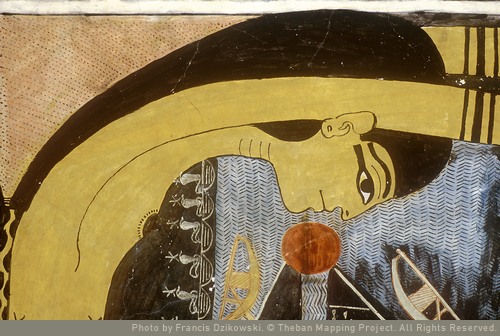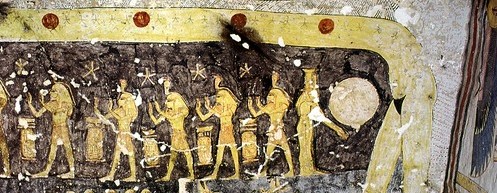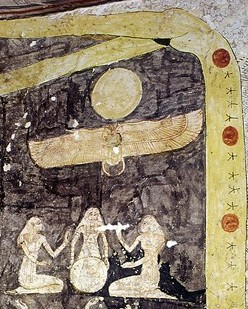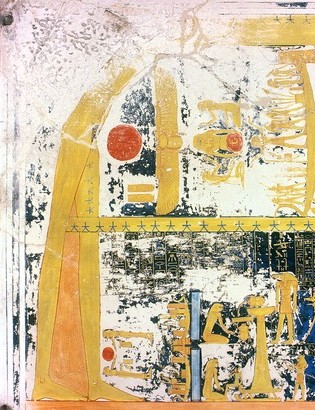The most evident proof of the importance in Ancient Egypt of Isis and Nephthys in a rebirth process is in the Books of the Day and Night, which describe the journey of the sun god through the sky.
According to the thought of Ancient Egypt, especially during the New Kingdom, Nut was the goddess of the sky, so the sun made a journey through the goddess’ body.

Nut swallowing the sun disk. Book of the Day. Tomb of Ramses V-VI. Photo: Thebanmapingproject
The dusk happened because Nut swallowed the solar disk and during the night he traveled all over the Nut’s belly. The morning after, the sunrise meant that Nut was giving birth the solar disk. That is the iconography that the artist of Ancient Egypt depicted on the ceilings of tombs from XX Dynasty.
But Nut was also Osiris’ mother and the resurrection of the dead in Ancient Egypt happened because the corpse was assimilated to Osiris, so the new-born was Osiris, son of Nut, who was assisted by Isis and Nephthys.
Taking that into consideration, it make sense that the priests of XX Dynasty included the figures of Isis and Nephthys in the sun disk rebirth. As a consequence the artists of Ancient Egypt had to create a new iconography with the union of the sun rebirth and the Osirian tradition of the two divine mourners.

Isis and Nephthys receiving the solar disk. Book of the Night. Tomb of Ramses IX. Photo: Thebanmappingproject
The solution was to depict the Nut’s labour with Isis and Nephthys as midwifes. Ancient Egypt artists found two different images for this same concept:

Isis and Nephthys as midwifes of Nut in her labour. Book of the Day. Tomb of Ramses IX. Ancient Egypt. Thebanmappingproject
1) Isis and Nephthys standing and becoming with their hands the solar disk directly from the Nut’s vagina.
2) Two women helping a squatting woman in labour depicted with a frontal perspective.
They three are not identified, but on one hand they are under a winged scarab with solar disk (the sun at sunrise) and next to the Nut’s genitals; on the other hand, the woman in labour is depicted with a frontal perspective, a feature of Nut’s depictions in the art of Ancient Egypt,
These three points refer us to the labour of Nut assisted by Isis and Nephthys.
The artists of ancient Egypt introduced a common image of Egyptian life into the sacred iconography.

Book of the Day (up) and Book of the Night (down).The two mourners Isis and Nephthys assisting the sun disk rebirth. Tomb of Ramses V-VI. Photo: Thebanmappingproject
Trackbacks/Pingbacks